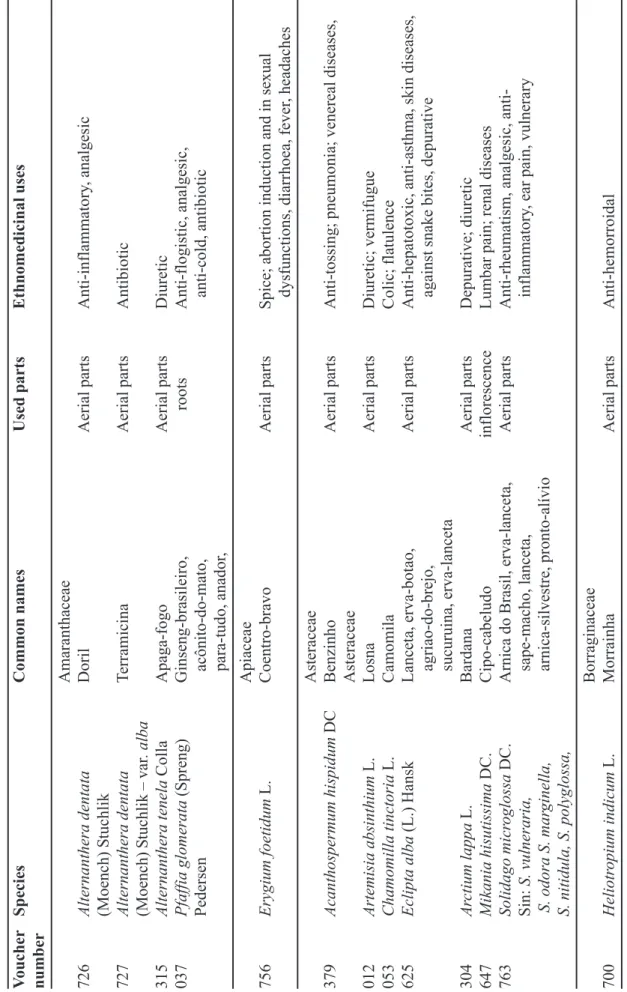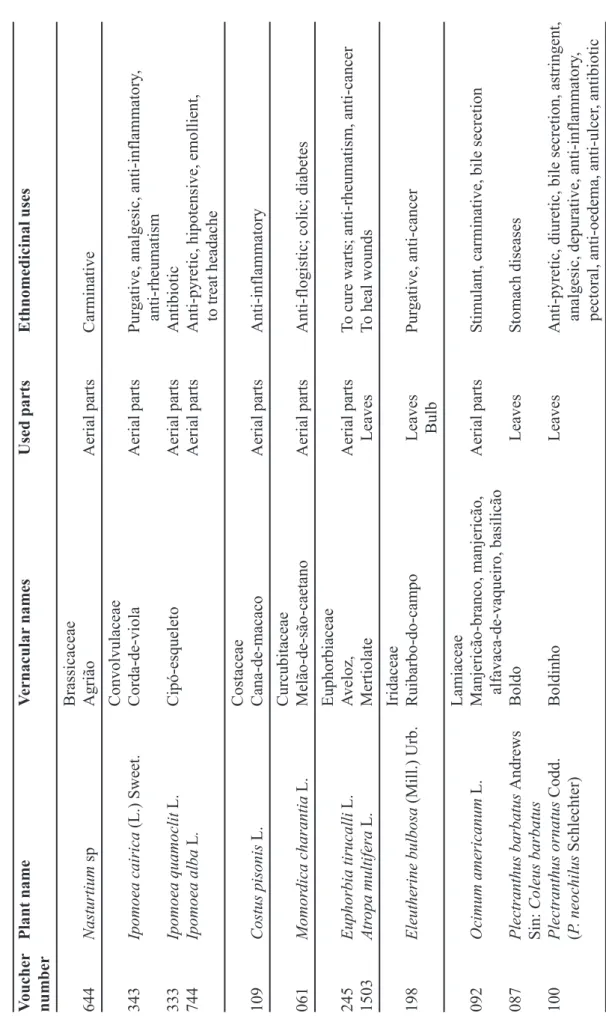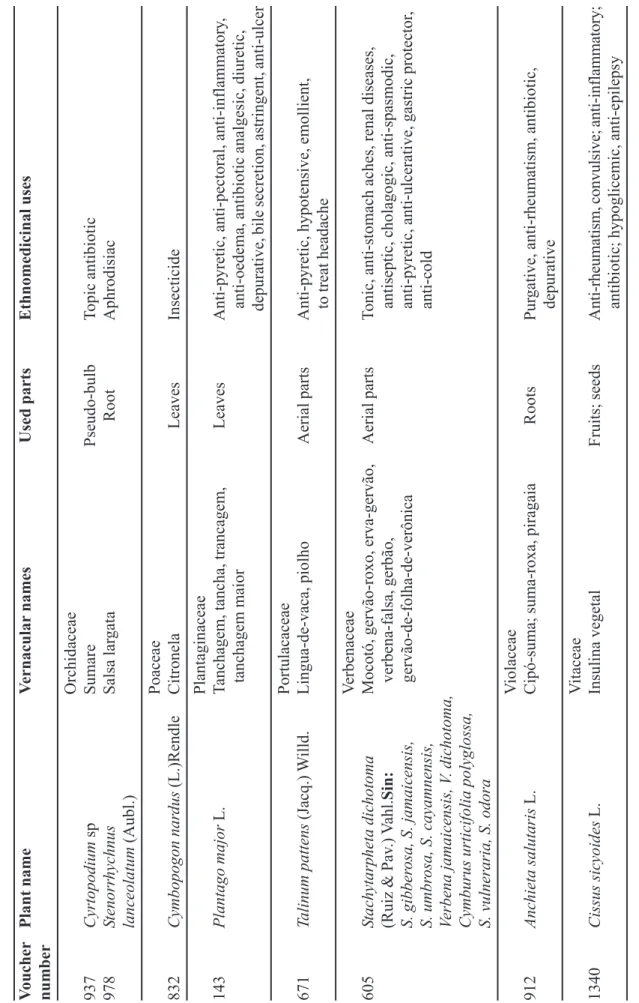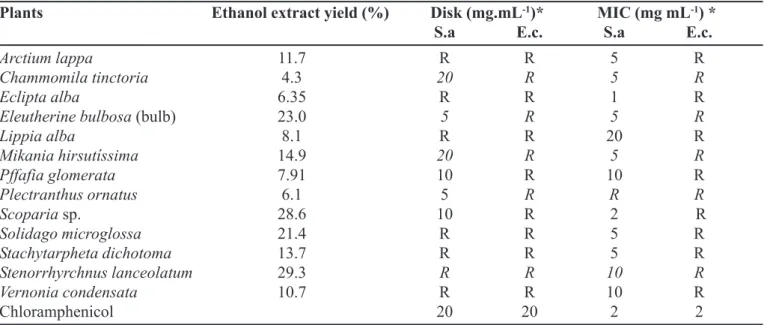vol. 42, n. 2, abr./jun., 2006
Antimicrobial and cytotoxic activities screening of some Brazilian
medicinal plants used in Governador Valadares district
Beatriz Gonçalves Brasileiro
1, Virgínia Ramos Pizziolo
1, Délio Soares Raslan
2, Claudia
Mashrouah Jamal
3, Dâmaris Silveira
4,*1Universidade Vale do Rio Doce, UNIVALE, Governador Valadares, MG, 2 Departamento de Química, ICEx,
Universidade Federal de Minas Gerais, UFMG, Belo Horizonte, MG, 3 Departamento de Farmácia, CBM (Centro
Biomédico, Universidade Federal do Espírito Santo, UFES, Vitória, ES, 4 Faculdade de Ciências da Saúde,
Universidade de Brasília, UnB, DF
Ethanol extracts from medicinal plants commonly used by Governador Valadares people were tested for antimicrobial activity and cytotoxicity (BST assay). The field survey was conducted during the years 1997-2000 by means of direct interviews with healing men (“raizeiros”) who showed familiarity with local used remedies. A total of 33 crude extracts from 32 plant species was studied. Ten extracts (Costus pisonis, Cymbopogon nardus, Eclipta alba, Eleutherine bulbosa, Erigium foetidium, Euphorbia tirucalli, Mikania hirsutissima, Momordica charantia, Solidago microglossa and Plectranthus ornatus) presented brine shrimp toxicity (LD50<1000 ppm). Thirteen extracts presented antimicrobial activity against Staphylococcus aureus: E. alba, Scoparia sp., Arctium lappa, Chammomila tinctoria, E. bulbosa, M. hirsutíssima, S. microglossa, Stachytarpheta dichotoma, Pffafia glomerata, Stenorrhyrchnus lanceolatum, Vernonia condensata and Lippia alba. None extract presented activity against Escherichia coli.
Uniterms • Ethnomedicine • Antimicrobial activity • Artemia salina *Correspondence: Dâmaris Silveira
Universidade de Brasília, UnB Asa Norte
70910-900 - Brasília, DF - Brasil E-mail: damaris@unb.br
INTRODUCTION
At the Vale do Rio Doce region, where is located Go-vernador Valadares County, Atlantic Forest is almost extinct, and the region is suffering an accelerated desertification process. Besides, in the beginning of Twenty Century, the ori-ginal indigenous land was occupied by people from several regions of the Country, and the traditional knowledge of that indigenous groups disappeared. Although medicinal plants are becoming extinct by deforestation and interest by the younger generation in learning about the folk medicine is
waning, there has been a recent resurgence of the medicinal plants uses in that region. On the other had, few chemical or biological studies about these species have been carried out. Considering the lack of information and in the aim to rescue some of this folk knowledge, healing men (“raizeiros”) from the region were contacted and asked to share with the researchers ethnobotanical information and to guide them collecting botanical material for further studies. As a result of this study, we present here a list of medicinal plants used in Governador Valadares County, based on healing men information, as well as a
Plant material
Collection and identification
The field survey was conducted during the years 1997-2000 by means of direct interviews with healing men (“raizeiros”) who showed familiarity with local used remedies. Aerial parts of the mentioned plants were collected, under supervision of “raizeiros”, from the ori-ginal vegetation, or from the raizeiro’ gardens. Voucher species were deposited at Herbarium of Universidade Vale do Rio Doce, UNIVALE. When possible, plants were growth at Horto Botânico of Universidade Vale do Rio Doce, in the aim to preserve the species.
The plants are listed in Table I in alphabetical order by their scientific name, followed by vernacular (Portuguese) names.
Extract preparation
Aerial parts were oven-dried at temperature under
40 oC, and powdered using knife mill. The powdered
material was extracted by maceration using 95% ethanol as solvent at room temperature. The extracts were then filtered and concentrated under vacuum in rotatory evaporator. All the extracts were kept in tightly stoppered bottle in a freezer until used for the biological tests or shared with another research groups.
Antimicrobial activity
The antimicrobial assays were performed by MIC determination and diffusion disc method (Ali-Shtayeh et al., 1998), using Staphylococcus aureus (ATCC 25985) and Escherichia coli (ATCC 25922). All assays were carried out in triplicate.
Agar diffusion disc method
Briefly, test solution was prepared with known
weight of crude extract, dissolved in 200 μL of DMSO.
Whatman no. 1 sterile filter paper discs (6 mm) were impregnated with extract (corresponding to 20, 10 and 5 mg/mL of crude plant extract). In vitro antibacterial activity was determined by using Mueller Hinton Agar. Petri plates were prepared by pouring 10 mL of Mueller Hinton Agar and allowed to solidify. Plates were dried and 0.1 mL of inoculum suspension was poured and uniformly spread. The discs were then applied and the plates were
Minimum inhibitory concentration (MIC)
Minimum inhibitory concentration was tested by the two-fold serial dilution method. The tested extract was dissolved and was incorporated into 0.5 mL of Mueller Hinton Agar to get a concentration of 20 mg/mL and serially diluted to achieve 10, 5, 2 mg/mL, respectively, and 0.5 mL suspension of the test organism was transferred on to each tube. The negative control tube contained only organisms and not the plant extract. The positive control tube contained only chloramphenicol (2 mg/mL). The culture tubes were incubated at 37 °C for 24 h. The lowest concentrations, which did not show any growth of tested organism after macroscopic evaluation was determined as MIC.
Minimum bactericidal concentration (MBC)
To confirm the activity, all the tubes used in the MIC study which did not show any growth of the bacteria after the incubation period were first diluted (1:4) in fresh Mueller Hinton Broth and then subcultured on to the surface of the freshly prepared Mueller Hinton Agar plates and incubated at 37 °C for 24 h. The MBC were recorded as the lowest concentration of the extract that did not permit any visible bacteria colony growth on the appropriate agar plate after the period of incubation.
Brine shrimp lethality test (BST)
The assay was performed basically according to simplified Meyer’s method (Meyer et al., 1982). Briefly, brine shrimp Artemia salina L. encysted eggs (Maramar) were incubated in artificial seawater at 28 °C. Samples were solved in 20 mL of artificial seawater. Serial dilutions (triplicate) were prepared in the same solution. Metanauplii (10 units) were added to each set of tubes containing samples and the cultures further incubated for 24 h. Controls containing only artificial seawater were included on set of experiment. Lapachol was used as reference standard. LC50 (after 24 h) was calculated by Probit analysis.
RESULTS AND DISCUSSION
The results of the screening of crude plant extracts about antimicrobial and brine shrimp toxicity (BST) activities are presented in Tables II and III, respectively. Meyer et al. (1982) classified crude extracts into toxic
TABLE I
Ethnobotanical data on medicinal species used in Governador
V aladares District V oucher Species Common names Used parts Ethnomedicinal uses number Amaranthaceae 726 Alternanthera dentata Doril Aerial parts Anti-inflammatory , analgesic (Moench) S tuchlik 727 Alternanthera dentata Terramicina Aerial parts Antibiotic (Moench) S tuchlik – var . alba 315 Alternanthera tenela Colla Apaga-fogo Aerial parts Diuretic 037 Pfaffia glomerata (Spreng) Ginseng-brasileiro, roots Anti-flogistic, analgesic, Pedersen acônito-do-mato, anti-cold, antibiotic para-tudo, anador , Apiaceae 756 Erygium foetidum L. Coentro-bravo Aerial parts
Spice; abortion induction and in sexual dysfunctions, diarrhoea, fever
, headaches Asteraceae 379 Acanthospermum hispidum DC Benzinho Aerial parts
Anti-tossing; pneumonia; venereal diseases,
Asteraceae 012 Artemisia absinthium L. Losna Aerial parts Diuretic; vermifugue 053 Chamomilla tinctoria L. Camomila Colic; flatulence 625 Eclipta alba (L.) Hansk Lanceta, erva-botao, Aerial parts
Anti-hepatotoxic, anti-asthma, skin diseases,
agriao-do-brejo,
against snake bites, depurative
sucuruina, erva-lanceta 304 A rctium lappa L. Bardana Aerial parts Depurative; diuretic 647 Mikania hisutissima DC. Cipo-cabeludo inflorescence
Lumbar pain; renal diseases
763
Solidago micr
oglossa
DC.
Arnica do Brasil, erva-lanceta,
Aerial parts
Anti-rheumatism, analgesic,
anti-Sin:
S. vulneraria,
sape-macho, lanceta,
inflammatory
, ear pain, vulnerary
S. odora S. mar ginella, arnica-silvestre, pronto-alívio S. nitidula, S. polyglossa, Borraginaceae 700 Heliotr opium indicum L. Morrainha Aerial parts Anti-hemorroidal
TABLE I -
(cont.) Ethnobotanical data on medicinal species used in Governador
V aladares District V oucher Plant name V ernacular names Used parts Ethnomedicinal uses number Brassicaceae 644 Nasturtium sp Agrião Aerial parts Carminative Convolvulaceae 343 Ipomoea cairica (L.) Sweet. Corda-de-viola Aerial parts Pur
gative, analgesic, anti-inflammatory
anti-rheumatism 333 Ipomoea quamoclit L. Cipó-esqueleto Aerial parts Antibiotic 744 Ipomoea alba L . Aerial parts
Anti-pyretic, hipotensive, emollient, to treat headache
Costaceae 109 Costus pisonis L. Cana-de-macaco Aerial parts Anti-inflammatory Curcubitaceae 061 Momor dica charantia L. Melão-de-são-caetano Aerial parts
Anti-flogistic; colic; diabetes
Euphorbiaceae 245 Euphorbia tirucalli L. A veloz, Aerial parts To
cure warts; anti-rheumatism, anti-cancer
1503 Atr opa multifera L. Mertiolate Leaves To heal wounds Iridaceae 198 Eleutherine bulbosa (Mill.) Urb. Ruibarbo-do-campo Leaves Pur gative, anti-cancer Bulb Lamiaceae 092 Ocimum americanum L. Manjericão-branco, manjericão, Aerial parts
Stimulant, carminative, bile secretion
alfavaca-de-vaqueiro, basilicão 087 Plectranthus barbatus Andrews Boldo Leaves Stomach diseases Sin: Coleus barbatus 100 Plectranthus ornatus Codd. Boldinho Leaves
Anti-pyretic, diuretic, bile secretion, astringent,
(P
. neochilus
Schlechter)
analgesic, depurative, anti-inflammatory pectoral, anti-oedema, anti-ulcer
TABLE I -
(cont.) Ethnobotanical data on medicinal species used in Governador
V aladares District V oucher Plant name V ernacular names Used parts Ethnomedicinal uses number Orchidaceae 937 Cyrtopodium sp Sumare Pseudo-bulb Topic antibiotic 978 Stenor rhychnus Salsa lar gata Root Aphrodisiac lanceolatum (Aubl.) Poaceae 832 Cymbopogon nar dus (L.)Rendle Citronela Leaves Insecticide Plantaginaceae 143 Plantago major L.
Tanchagem, tancha, trancagem,
Leaves
Anti-pyretic, anti-pectoral, anti-inflammatory
,
tanchagem maior
anti-oedema, antibiotic analgesic, diuretic, depurative, bile secretion, astringent, anti-ulcer
Portulacaceae 671 Talinum pattens (Jacq.) W illd. Lingua-de-vaca, piolho Aerial parts
Anti-pyretic, hypotensive, emollient, to treat headache
V
erbenaceae
605
Stachytarpheta dichotoma
Mocotó, gervão-roxo, erva-gervão,
Aerial parts
Tonic, anti-stomach aches, renal diseases,
(Ruiz & Pav
.)
V
ahl.
Sin:
verbena-falsa, gerbão,
antiseptic, cholagogic, anti-spasmodic,
S. gibber
osa, S. jamaicensis,
gervão-de-folha-de-verônica
anti-pyretic, anti-ulcerative, gastric protector
, S. umbr osa, S. cayamnensis, anti-cold Verbena jamaicensis, V . dichotoma,
Cymburus urticifolia polyglossa, S. vulneraria, S. odora
V
iolaceae
912
Anchieta salutaris
L.
Cipó-suma; suma-roxa, piragaia
Roots
Pur
gative, anti-rheumatism, antibiotic,
depurative V itaceae 1340 Cissus sicyoides L. Insulina vegetal Fruits; seeds
(LC50 < 1000 ppm) and non-toxic (LC50 >1000 ppm), according to the levels required to attain the LC50 in the BST assay. Based on this classification, ten extracts (C. pisonis, C. nardus, E. alba, E. bulbosa, E. foetidium, E. tirucalli, M. hirsutíssima, M. charantia, S. microglossa and P. ornatus) presented BST (LD50< 1000 ppm). In addition, ethanol extract of E. tirucalli, M. charantia and P. ornatus presented LD50 values lower than lapachol (positive control).
The extracts were considered to have antimicrobial activity when presented inhibition halo bigger or equal that promoted by chloramphenicol (20 mg/mL chloramphenicol promoted 25 mm inhibition halo, measured by the center of the disc). Then, thirteen extracts presented antimicrobial activity against S. aureus: E. alba (S>1 mg/mL); Scoparia sp. (S>2 mg/mL); A. lappa, C. tinctoria, E. bulbosa, M. hirsutíssima, S. microglossa e S. dichotoma (S>5 mg/mL); P. glomerata, S. lanceolatum, V. condensata (S>10 mg/mL); L. alba (S>20 mg/mL). None presented activity against E. coli. Although some species are used in folk medicine as antibiotic or depurative, at the assay conditions, no antimicrobial activity was detected: Alternanthera dentata var. alba (terramicina), Acanthospermum hispidum (benzinho), Ipomoea quamoclit (cipó-esqueleto), Cyrtopodium sp (sumaré), Plantago major (tanchagem), Stachytarpheta dichotoma (gervão-roxo), Anchieta salutaris (suma-roxa) and Cissus sicyoides (insulina vegetal), all of them nominated by “raizeiros” as antibiotic or depurative remedies, did not present such activity. On the other hand, species without ethnomedicinal report about antibiotic activity inhibited bacteria growth. Curiously, Chamomilla
tinctoria, which inhibit S. aureus growth, was not nominated as an antibiotic remedy by “raizeiros”, despite several reports at literature present extracts from Chamomilla species as an antimicrobial agent (Benetti, Manganelli, 1985; Lu et al., 1998; Stamatis et al., 2003; Mazokopakis et al., 2005).
Bara and Vanetti (1998) tested extracts from A. lappa and P. major against S. aureus and those extracts did not present activity. In another work, Freitas et al. (2002) showed that the hydro-ethanol extract obtained from leaves of P. major was effective against S. aureus. Despite Pessini et al. (2003) had been tested Lippia alba ethanol extract and
Arctium lappa 11.7 R R 5 R
Chammomila tinctoria 4.3 20 R 5 R
Eclipta alba 6.35 R R 1 R
Eleutherine bulbosa (bulb) 23.0 5 R 5 R
Lippia alba 8.1 R R 20 R Mikania hirsutíssima 14.9 20 R 5 R Pffafia glomerata 7.91 10 R 10 R Plectranthus ornatus 6.1 5 R R R Scoparia sp. 28.6 10 R 2 R Solidago microglossa 21.4 R R 5 R Stachytarpheta dichotoma 13.7 R R 5 R Stenorrhyrchnus lanceolatum 29.3 R R 10 R Vernonia condensata 10.7 R R 10 R Chloramphenicol 20 20 2 2
* = concentration that promote inhibition zone; R= inactive; S.a.=Staphylococcus aureus; E.c.=Escherichia coli
TABLE III - Toxicity of medicinal plants from Governador
Valadares, Brazil, against Artemia salina brine shrimp
plant LD50 a (ppm) RT b (%)
lapachol (control) 59.17 100.0
Costus pisonis 389.26 15.2
Cymbopogon nardus 118.92 50.0
Eclipta alba 352.92 16.8
Eleutherine bulbosa (bulb) 269.59 21.9
Erygium foetidium 885.37 6.7 Euphorbia tirucalli 23.10 256.1 Mikania hirsutíssima 634.84 9.3 Mormordica charantia 41.33 143.2 Plectranthus ornatus 31.93 185.3 Solidago microglossa 72.42 81.7 a LD
50 : Lethal doses at 50% population; b RT: relative
without finding activity, the sample tested by our group presented S. aureus inhibition at concentration of 5 mg/mL. A total of 33 plant extracts from 32 different plant species (one with two varieties) belonging to 9 families were studied. Table I presents the botanical names and voucher specimens numbers, the vernacular names and their uses in traditional medicine, as known according to information mainly collected by MSc Beatriz Gonçalves Brasileiro through interviews with local traditional healers. The fairly good degree of correlation of traditional medicine claims with the biological activities as observed in the present preliminary study results, warrant further investigation. Activity guided fractionation and phytochemical investigation of some species are already underway by our group.
From Plectranthus ornatus have been isolated several diterpenes and triterpenes (Oliveira et al., 2005; Oliveira, 2002). Ipomoea cairica presented antinociceptive activity in vivo (Ferreira et al., 2005). From ethanol and hydro-ethanol extracts of I. cairica were isolated lignans, triterpenes, and caffeic acid derivatives (Ferreira et al., 2005). Preliminary studies showed Euphorbia tirucalli ethanol extract induces an increase on human peripheral blood mononuclear cells (PBMC) proliferative response (Malaquias et al., 2000).
RESUMO
Triagem das atividades antimicrobiana e citotóxica de algumas plantas medicinais brasileiras usadas na
cidade de Governador Valadares
Os extratos etanólicos de plantas medicinais utilizadas por moradores da cidade de Governador Valadares foram ava-liados quanto às atividades antimicrobiana e citotóxica. A pesquisa de campo foi realizada durante o período de 1997-2000, por meio de entrevistas com os raizeiros locais. Fo-ram avaliados 33 extratos brutos de um total de 32 espéci-es. Desses extratos, dez apresentaram toxicidade às larvas de Artemia salina (DL50<1000 ppm): Costus pisonis, Cymbopogon nardus, Eclipta alba, Eleutherine bulbosa, Erigium foetidium, Euphorbia tirucalli, Mikania hirsutissima, Momordica charantia, Solidago microglossa e Plectranthus ornatus. Quanto à atividade antimicrobiana, nenhum dos extratos apresentou atividade contra Escherichia coli. Entretanto, treze extratos mostraram-se ativos contra Staphylococcus aureus: E. alba, Scoparia sp., Arctium lappa, Chammomila tinctoria, E. bulbosa, M. hirsutíssima, S. microglossa, Stachytarpheta dichotoma, Pffafia glomerata, Stenorrhyrchnus lanceolatum, Vernonia condensata e Lippia alba.
UNITERMOS: Etnomedicina. Artemia salina. Atividade antimicrobiana.
ACKNOWLEDGEMENTS
The authors are indebted with raizeiros for informations and Fundação Percival Farqhuar, Governa-dor Valadares, Brazil for financial support.
REFERENCES
ALI-SHTAYEH, M.S.; YAGHMOUR, M-R.; FAIDI, Y.R.; SALEM, K.; AL-NURY, M.A Antimicrobial activity of 20 plants used in folkloric medicine in the Palestinian area. J. Ethnopharmacol., v. 60, p. 265-270, 1998. BARA, M.T.F.; VANETTI, M.C.D. Antimicrobial activity of
medicinal plants and natural dyes. Rev. Bras. Farmacogn., v. 7/8, p. 23-34, 1998.
BENETTI, C.; MANGANELLI, F. Clinical experiences in the pharmacological treatment of vaginitis with a camomile-extract vaginal douche. Minerva Ginecol., v. 37, p. 799-801, 1985.
FERREIRA, A.A.; AMARAL, F.A.; DUARTE, I.D.G.; OLIVEIRA, P.M.; ALUES, R.B.; SILVEIRA, D.; AZEVEDO, A.O.; RASLAN, D.S.; CASTRO, M.S.A. Antinociceptive effect from Ipomea cairica extracts. J. Ethnopharmacol., v. 105, p.148-153, 2006.
FERREIRA, A.A.; SILVEIRA, D; ALVES, R.B; OLIVEIRA, P.M.; RASLAN, D.S. Constituents of Ipomoea cairica ethanolic extract. Chem. Nat. Compounds, v. 41, p.465, 2005.
FREITAS, A.G.; COSTA, V.; FARIAS, E.T.; LIMA, M.C.A.; SOUSA, I.A.; XIMENES, E. A. Antimicrobial activity of Plantago major L. Rev. Bras Farmacogn., v. 12, p. 64-65, 2002.
LU, T.; CANTRELL, C.L.; ROBBS, S.L.; FRANZBLAU, S.G.; FISCHER, N.H. Antimycobacterial matricaria esters and lactones from Asteraceae species. Planta Medica, v. 64, p. 665-667, 1998.
MALAQUIAS, L.C.C.; DALCOMO, P.R.; ALVES-OLIVEIRA, L.F.; BRASILEIRO, B.G.; DUARTE, D.S. Effects on plant extract from Euphorbia tirucalli on the PBMC proliferative response. International Meeting on Imunoregulation: Insigts for therapeutic Intervention, p. 95. Florianópolis. 2000.
12, p. 25-27, 2005.
MEYER, B.N.; FERRIGNI, N.R.; PUTNAM, J.E.; JACOBSEN, L.B.; NICHOLS, D.E.; MCLAUGHLIN, J.L. Brine shrimp: a convenient general bioassay for active plants constituents. Planta Medica, v. 45, p. 31-34, 1982.
OLIVEIRA, P.M. Estudo químico das partes aéreas de Plectranthus ornatus (Lamiaceae). Belo Horizonte, 2002.132p. [Dissertação de Mestrado – ICEX-UFMG].
2005.
PESSINI, G.L.; HOLETZ, F.B.; SANCHES, N.R.; CORTEZ, D.A.G.; DIAS FILHO, B.P.; NAKAMURA, C.V. Evaluation of antibacterial and fungicide activities of plant extracts used in folk medicine. Rev. Bras. Farmacogn., v.13, p.21-24, 2003.
STAMATIS, G.; KYRIAZOPOULOS, P.; GOLEGOU, S.; BASAYIANNIS, A.; SKALTSAS, S.; SKALTSA, H. In vitro anti-Helicobacter pylori activity of Greek herbal medicines. J. Ethnopharmacol., v. 88, p. 175-179, 2003. Recebido para publicação em 12 de maio de 2005. Aceito para publicação em 16 de março de 2006.



